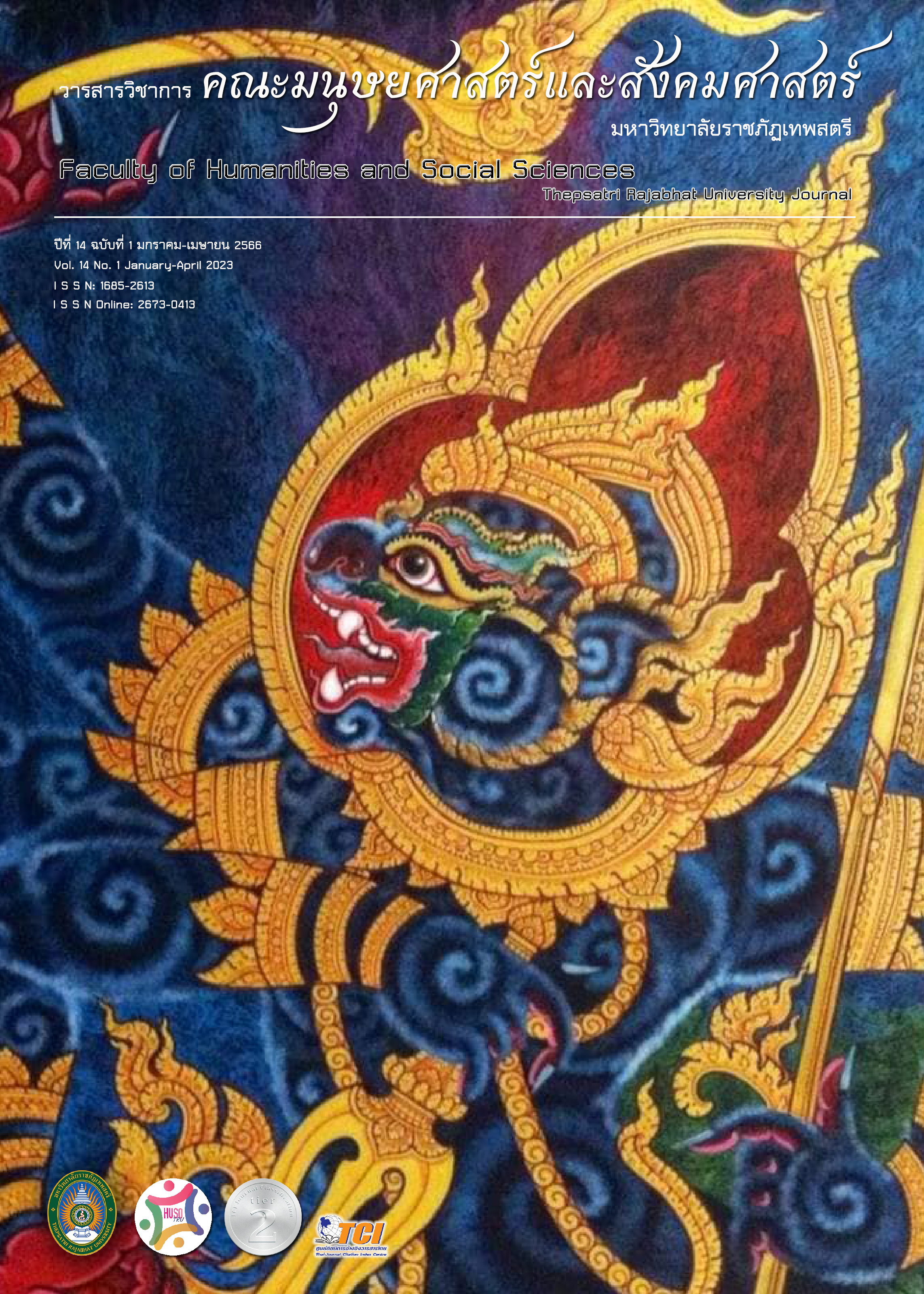Communication Approaches for Khanom La Story in the Situation of the Covid - 19 Pandemic
Main Article Content
Abstract
The purposes of the research were to 1. study the situation of the distribution of Kanom La Products, Nakhon Si Thammarat Province during the Covid - 19 pandemic. and 2. to propose approaches for communicating the story of Khanom La in the situation of the Covid - 19 pandemic. This qualitative research was conducted and obtained data from key informants who are 5 groups of Khanom La entrepreneurs in Nakhon Si Thammarat Province. They were recruited using purposive sampling technique. The instrumentation consisted of interviews and observations and content analysis was applied during data analysis. The research findings showed that 1. the distribution of Khanom La Products, Nakhon Si Thammarat Province was affected during the pandemic of Covid - 19. This made the decline in products distribution, and 2. in order for entrepreneurs to communicate the story of Khanom La to stimulate distribution during the pandemic of COVID - 19, the approaches consist of product communication approach which presents highlight and identity stories of Khanom La in each area, social media approach, using various content approach, using both still images and motion pictures approach, communicating with continuity approach and developing marketing communication skills for entrepreneurs of Khanom La approach.
Downloads
Article Details

This work is licensed under a Creative Commons Attribution-NonCommercial-NoDerivatives 4.0 International License.
The content and information presented in articles published in the Academic Journal of the Faculty of Humanities and Social Sciences, Thepsatri Rajabhat University, are solely the opinions and responsibilities of the respective authors. The editorial board of the journal neither necessarily agrees with nor assumes any responsibility for such content in any manner whatsoever.
All articles, information, content, and images published in the Academic Journal of the Faculty of Humanities and Social Sciences, Thepsatri Rajabhat University, are the copyright of the journal. Any person or organization wishing to reproduce, disseminate, or otherwise utilize all or any part thereof must obtain prior permission from the Academic Journal of the Faculty of Humanities and Social Sciences, Thepsatri Rajabhat University.
References
กฤตกร หมั่นสระเกษ, รําไพ หมั่นสระเกษ, และเกวลี หมั่นสระเกษ. (2564, มกราคม - เมษายน). ชีวิตวิถีใหม่กับเทคนิคการดูแลตนเองเพื่อเสริมสร้างภูมิคุ้มกันในช่วงที่มีการระบาดของโรคโควิด - 19. วารสารสุขภาพและการศึกษาพยาบาล, 27(1), 206 - 218.
กิริยา กุลกลการ, อนันต์ ภาวสุทธิไพศิฐ, และศุทธาภา นพวิญญูวงศ์. (2563). รายงานวิจัยเรื่อง ผลกระทบของ COVID - 19 ต่อการส่งเสริมการมีงานทำ มหาวิทยาลัยธรรมศาสตร์. กรุงเทพฯ: สำนักงานศูนย์วิจัยและให้คำปรึกษาแห่งมหาวิทยาลัยธรรมศาสตร์.
ฉัตรี กันพ้นภัย. (2563). พฤติกรรมการบริโภคอาหารนอกบ้านของประชากร ในอำเภอบ้านตาก ก่อนเกิดวิกฤติโควิด - 19 กับหลังการเกิดวิกฤติโควิด - 19. บทความวิชาการการค้นคว้าอิสระ มหาวิทยาลัยรามคำแหง.
ฐิติมา บูรณวงศ์, และศณัทชา ธีระชุนห์. (2565, มกราคม - เมษายน). การศึกษาพฤติกรรมผู้บริโภคและแนวทางในการพัฒนาผลิตภัณฑ์ขนมลาของกลุ่มวิสาหกิจชุมชน ในจังหวัดนครศรีธรรมราช. วารสารนาคบุตรปริทรรศน์, 1(14), 43 - 54.
ฑิตาพร รุ่งสถาพร, และปฐมา สตะเวทิน. (2563, พฤษภาคม - สิงหาคม). พฤติกรรมผู้บริโภคต่อการซื้อสินค้าบนช่องทางออนไลน์ในภาวะวิกฤตโควิด - 19 ในเขตกรุงเทพมหานครปริมณฑล และพิษณุโลก. วารสารนิเทศศาสตร์, 39(2), 119 - 133.
พัฒน์กมล อ่อนสำลี. (2564, มกราคม - มิถุนายน). การปรับตัวของวิสาหกิจชุมชนในสภาวะการแพร่ระบาดของโรคติดเชื้อไวรัสโคโรนา. วารสารวิทยาการจัดการปริทัศน์, 23(1), 195 - 205.
มณีรัตน์ กำลังเกื้อ, และวรรณนะ หนูหมื่น. (2560, กรกฎาคม - กันยายน). บุญสารทเดือนสิบกับการปรับเปลี่ยนเป็นประเพณีประดิษฐ์. วารสารวิจัยและพัฒนา มหาวิทยาลัยราชภัฏเลย, 12(41), 34 - 46.
มนัสชนก ไชยรัตน์. (2563). พฤติกรรมผู้บริโภคที่เปลี่ยนแปลงไปช่วงสถานการณ์ COVID - 19 ในพื้นที่กรุงเทพมหานคร. สืบค้นเมื่อ กรกฎาคม 13, 2565, จาก https://mmm.ru.ac.th/MMM/IS/vlt15-1/6114993677.pdf.
สมพงษ์ เส้งมณีย์. (2564). แนวทางการพัฒนารูปแบบการสื่อสารการตลาดแบบบูรณาการเพื่อส่งเสริมคุณค่าตราสินค้าการท่องเที่ยวชุมชน จังหวัดจันทบุรี. ปริญญานิพนธ์ดุษฎีบัณฑิต มหาวิทยาลัยธุรกิจบัณฑิตย์.
สุตาภัทร คงเกิด. (2563, กุมภาพันธ์). การพัฒนากลยุทธ์การตลาดเชิงเนื้อหาออนไลน์ ของกลุ่มธุรกิจหัตถกรรมผ้าทอ จังหวัดเชียงใหม่. วารสารสังคมศาสตร์และมานุษยวิทยาเชิงพุทธ, 5(2), 239 - 254.
Sundin, A., Andersson†, K., & Watt, R. (2018, February). Rethinking Communication: Integrating Storytelling for Increased Stakeholder Engagement in Environmental Evidence Synthesis. Environmental Evidence, 7(6), 1 - 6. Retrieve May 28, 2022, from https://doi.org/10.1186/s13750-018-0116-4 COMMENTARY.


